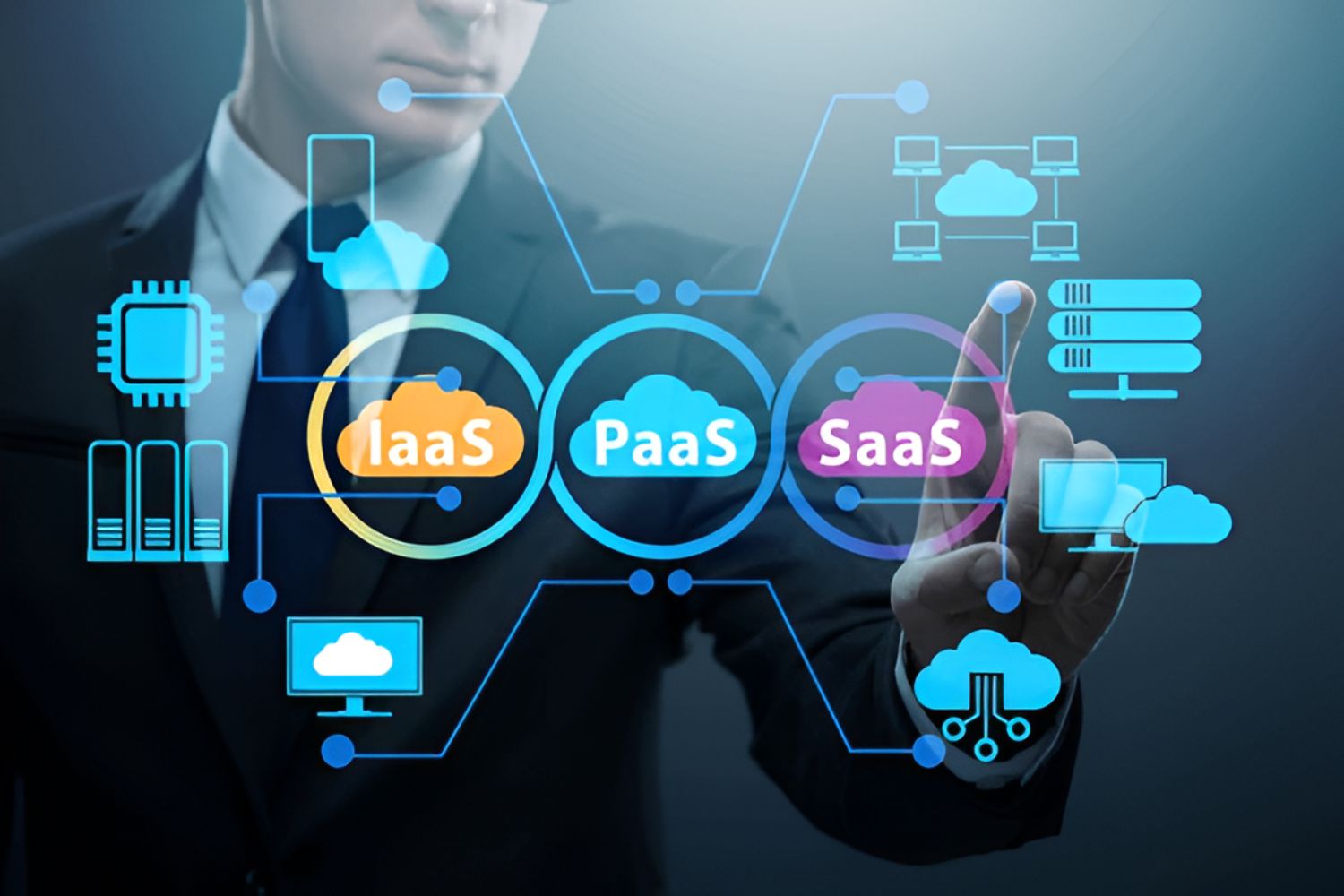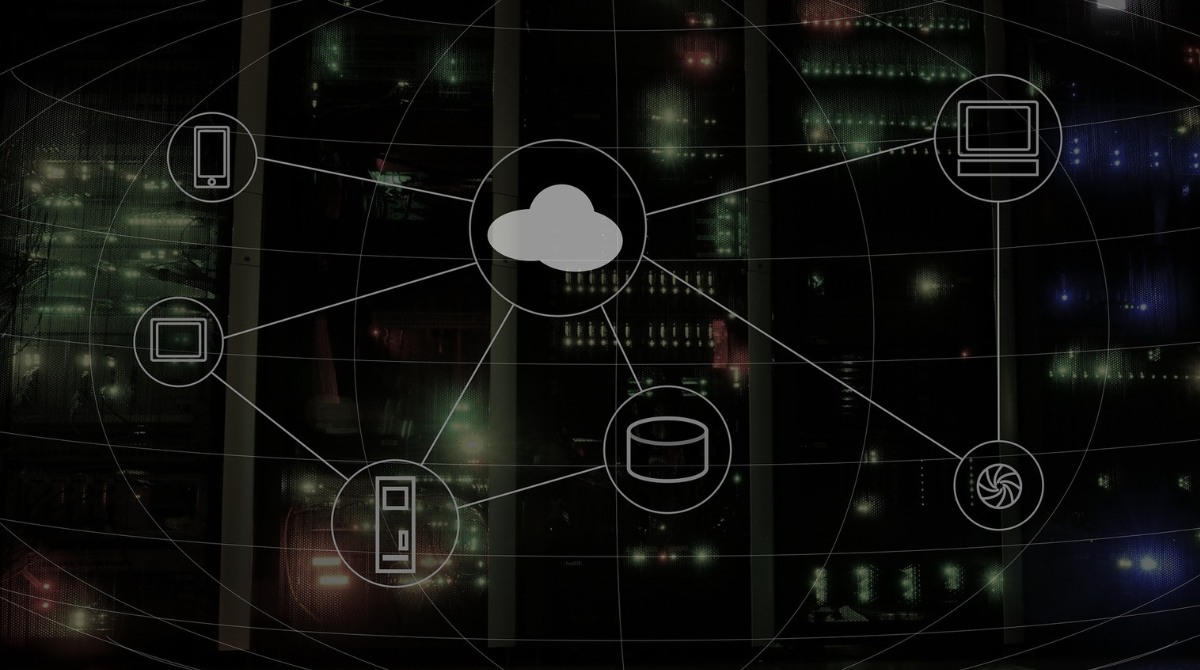Introduction
Welcome to the world of cloud computing, where technology continuously evolves and revolutionizes the way businesses operate. One of the key components of cloud computing is Software as a Service (SaaS), which has gained significant popularity in recent years. SaaS is a software delivery model that allows users to access applications directly from the internet, eliminating the need for complex on-premises installations.
SaaS offers a host of benefits to businesses of all sizes, making it a preferred choice for many organizations. From cost savings and scalability to increased productivity and flexibility, SaaS has transformed the way software solutions are accessed and utilized. In this article, we will explore the concept of SaaS in cloud computing, its characteristics, benefits, examples, and how it differs from other cloud computing models.
Cloud computing has brought about a paradigm shift in the IT industry. Instead of relying on traditional software installations, businesses can now leverage the power of the cloud to access applications and services. SaaS, in particular, offers a hassle-free solution for organizations, as it eliminates the need for purchasing and managing software licenses and hardware infrastructure. With SaaS, users can simply connect to the internet and start using the application, with all maintenance and updates handled by the service provider.
SaaS is characterized by its multi-tenant architecture, where multiple users can access the same application simultaneously. This allows for efficient resource utilization and cost-sharing among users. Additionally, SaaS applications are typically accessed through a web browser or a thin client, providing users with the flexibility to access the application from anywhere, on any device with an internet connection.
Some of the major benefits of using SaaS include:
- Cost Savings: SaaS eliminates the need for upfront investment in software licenses and hardware infrastructure. Users can opt for a pay-as-you-go subscription model, allowing for cost savings and predictable expenses.
- Scalability: SaaS applications can easily scale up or down based on the needs of the business. Users can add or remove users, storage, or features as required, without any major disruptions.
- Flexibility: With SaaS, users have the freedom to access applications from any location, using any device with an internet connection. This enables remote work and collaboration, increasing productivity and efficiency.
- Automatic Updates: SaaS service providers take care of all software updates and maintenance, ensuring that users always have access to the latest features and security enhancements.
- Integration: SaaS applications can easily integrate with other software solutions, allowing for seamless data exchange and streamlined business processes.
Now that we have covered the basics of SaaS in cloud computing, let’s delve deeper into some examples of popular SaaS applications and how SaaS works in the cloud.
Definition of SaaS
Software as a Service (SaaS) is a software delivery model in which applications are provided over the internet by a service provider. In a SaaS model, users can access the software through a web browser or a thin client, without the need for traditional on-premises installations.
Unlike traditional software deployment models, where businesses purchase licenses and install the software on their own servers, SaaS allows users to subscribe to a service and access the software on-demand. The service provider is responsible for maintaining the infrastructure, performing updates, and ensuring the availability and security of the software.
One of the key features of SaaS is its multi-tenant architecture. In a multi-tenant environment, multiple users or organizations share a single instance of the software, but their data and configurations are kept separate. This ensures efficient resource utilization and cost-sharing among users, providing significant benefits in terms of scalability and cost savings.
SaaS applications are delivered to users through the internet, making them accessible from anywhere, at any time. Users can access the software on different devices, including desktops, laptops, tablets, and smartphones, as long as they have an internet connection and a compatible web browser. This flexibility enables remote work and collaboration, allowing users to work on projects and share data seamlessly.
Service Level Agreements (SLAs) are an integral part of SaaS offerings. SLAs define the level of service availability, performance, and support that the service provider will deliver to the users. This ensures that users have access to the software when they need it and that any issues or disruptions are promptly addressed by the service provider.
Overall, SaaS offers significant advantages over traditional software models. It eliminates the need for upfront investments in hardware and software licenses, provides scalability and flexibility, and offloads the responsibility of infrastructure management and software updates to the service provider. This allows businesses to focus on their core competencies and leverage the benefits of cloud computing in a cost-effective and efficient manner.
Characteristics of SaaS
Software as a Service (SaaS) is known for its distinctive characteristics that differentiate it from other software deployment models. Understanding these characteristics is crucial for businesses to make informed decisions about adopting SaaS solutions. Let’s explore the key characteristics of SaaS:
- On-Demand Accessibility: SaaS applications are accessible over the internet, allowing users to access them on-demand without the need for complex installations or hardware infrastructure. Users can simply log in to the application through a web browser and start using it.
- Multi-Tenancy: SaaS applications are hosted on shared infrastructure, with multiple users or organizations accessing a single instance of the software. Each user’s data and configurations are kept separate and secure, ensuring privacy and security.
- Automatic Updates: SaaS service providers are responsible for managing and updating the software. This includes installing updates, patches, and security enhancements, ensuring that users always have access to the latest features and improvements.
- Scalability: SaaS applications are designed to scale based on business needs. Users can easily add or remove users, storage, or features without significant disruptions. This scalability allows businesses to adapt and grow without worrying about the limitations of their software infrastructure.
- Pricing Model: SaaS typically operates on a subscription-based pricing model, where users pay a recurring fee to access the software. This eliminates the need for upfront investments in software licenses and hardware infrastructure, making SaaS a cost-effective solution.
- Customization: SaaS applications often provide options for customization, allowing businesses to tailor the software to their specific needs. This can include branding, user interface customization, workflow automation, and integration with other software solutions.
- Integration: SaaS applications are designed to easily integrate with other software solutions. This enables seamless data exchange and streamlines business processes. Integration capabilities reduce manual data entry, increase efficiency, and provide a holistic view of business operations.
- Reliability and Security: SaaS service providers prioritize security and reliability. They implement robust security measures to protect user data, such as encryption, data backup, and access control. Service providers also ensure high availability through redundant infrastructure and disaster recovery mechanisms.
These characteristics make SaaS an attractive option for businesses looking to leverage the benefits of cloud computing. By offering on-demand accessibility, scalability, automatic updates, and integration capabilities, SaaS empowers businesses to focus on their core competencies while benefiting from cost savings, flexibility, and efficiency.
Benefits of SaaS
Software as a Service (SaaS) offers a myriad of benefits to businesses of all sizes and industries. From cost savings to increased productivity, SaaS has revolutionized the way software solutions are accessed, utilized, and managed. Let’s explore some key benefits of SaaS:
- Cost Savings: SaaS eliminates the need for upfront investment in software licenses and hardware infrastructure. Users can subscribe to a pay-as-you-go model, where they pay a recurring fee based on their usage. This subscription-based pricing structure allows businesses to allocate their budget more effectively and avoid costly investments in software that may become obsolete or underutilized.
- Scalability: SaaS applications are designed to scale based on business needs. Users can easily add or remove users, storage, or features without significant disruptions. This scalability allows businesses to expand or downsize effortlessly, aligning their software infrastructure with the current demand. Businesses can grow without worrying about the limitations of their software, enabling them to be agile and responsive to market changes.
- Flexibility and Accessibility: SaaS applications can be accessed from anywhere, at any time, as long as there is an internet connection. This flexibility empowers businesses to embrace remote work opportunities, enabling employees to work from anywhere and using any device. The accessibility of SaaS applications also promotes collaboration, as teams can access and work on the same software in real-time, regardless of their physical location.
- Automatic Updates: SaaS service providers are responsible for managing and updating the software. Users do not need to worry about installing updates, patches, or security enhancements manually. This ensures that businesses always have access to the latest features and improvements, without disruptions or downtime. Automatic updates also alleviate the burden on IT departments, allowing them to focus on more strategic initiatives instead of spending time on software maintenance.
- Integration and Compatibility: SaaS applications are designed to integrate seamlessly with other software solutions, enabling data exchange and streamlining business processes. This integration capability eliminates the need for manual data entry and reduces errors and duplications. Businesses can integrate SaaS applications with their existing software ecosystem, such as CRM, ERP, and accounting systems, improving efficiency and providing a comprehensive view of operations.
- Improved Collaboration: SaaS applications foster collaboration among teams by providing real-time access to shared documents and applications. Teams can collaborate on projects, share information, and communicate more efficiently, even when working remotely. This collaboration enhances productivity and teamwork, enabling businesses to accomplish more in less time.
By leveraging the benefits of SaaS, businesses can reduce costs, improve efficiency, increase flexibility, and stay competitive in a rapidly evolving digital landscape. The scalability, accessibility, automatic updates, integration capabilities, and enhanced collaboration offered by SaaS empower businesses to focus on their core competencies and achieve their goals effectively.
Examples of SaaS Applications
Software as a Service (SaaS) has gained immense popularity across various industries, offering a wide range of applications that cater to different business needs. Let’s explore some examples of popular SaaS applications:
- Customer Relationship Management (CRM) Software: CRM SaaS applications allow businesses to manage and analyze customer interactions, track sales activities, and optimize customer relationships. Examples of CRM SaaS applications include Salesforce, HubSpot, and Zoho CRM.
- Human Resources Management (HRM) Software: HRM SaaS applications enable businesses to streamline HR processes, including employee onboarding, performance management, payroll, and benefits administration. Examples of HRM SaaS applications include Workday, BambooHR, and ADP WorkforceNow.
- Enterprise Resource Planning (ERP) Software: ERP SaaS applications integrate various aspects of business operations, such as finance, supply chain management, inventory control, and manufacturing. Examples of ERP SaaS applications include Oracle NetSuite, SAP Business ByDesign, and Microsoft Dynamics 365.
- Project Management Software: Project management SaaS applications assist in planning, tracking, and collaborating on projects, optimizing resource allocation and task management. Examples of project management SaaS applications include Asana, Trello, and Monday.com.
- Document Management Software: Document management SaaS applications facilitate efficient organization, storage, and retrieval of documents, enhancing collaboration and version control. Examples of document management SaaS applications include Google Drive, Dropbox, and Box.
- Video Conferencing Software: Video conferencing SaaS applications enable businesses to conduct remote meetings, facilitate collaboration, and enhance communication among teams. Examples of video conferencing SaaS applications include Zoom, Microsoft Teams, and Cisco Webex.
- Email Marketing Software: Email marketing SaaS applications automate email campaigns, manage subscriber lists, and analyze email performance to improve marketing efforts. Examples of email marketing SaaS applications include Mailchimp, Constant Contact, and Campaign Monitor.
- Accounting Software: Accounting SaaS applications offer tools for managing financial transactions, invoicing, budgeting, and financial reporting. Examples of accounting SaaS applications include QuickBooks Online, Xero, and FreshBooks.
These are just a few examples of the diverse range of SaaS applications available. From sales and marketing to project management and HR, businesses can find SaaS solutions tailored to their specific needs. The flexibility, scalability, and cost-effectiveness of SaaS applications make them an attractive option for businesses looking to leverage cutting-edge software without the burden of managing infrastructure and software updates.
How SaaS Works in Cloud Computing
Software as a Service (SaaS) works within the framework of cloud computing, delivering applications, services, and resources over the internet to users. Let’s explore how SaaS operates in the realm of cloud computing:
In traditional software models, businesses would install software applications on their own servers or computers. This required significant upfront investment in hardware infrastructure, software licenses, and IT maintenance. With SaaS, businesses can eliminate these complexities and instead access software applications directly from the cloud.
In the SaaS model, the software provider hosts the application on their servers and manages the infrastructure and data storage. Users can access the application through a web browser or a thin client, using their devices and an internet connection. This eliminates the need for users to install and maintain software on their local machines.
SaaS applications are typically delivered under a subscription-based pricing model. Users pay a recurring fee to access the software, usually based on factors such as the number of users or usage levels. This subscription fee covers the cost of infrastructure, maintenance, updates, and support provided by the service provider.
SaaS applications are designed with a multi-tenant architecture. This means that multiple users or organizations can access a single instance of the software, while their data and configurations remain isolated and secure. The multi-tenant architecture allows for efficient resource utilization and cost-sharing among users.
The cloud infrastructure that supports SaaS applications consists of servers, storage, and network resources. These resources are managed and maintained by the service provider, ensuring high availability, scalability, and robust security measures.
One of the key advantages of SaaS in cloud computing is the ability to easily scale up or down based on business needs. Users can add or remove users, storage, or features without significant disruptions. This scalability allows businesses to adapt to changing requirements and optimize their software usage and costs.
Another important aspect of SaaS in cloud computing is the automatic updates and maintenance provided by the service provider. The provider ensures that the software is up to date with the latest features, security patches, and performance enhancements. This relieves businesses from the burden of managing software updates and allows them to focus on their core operations.
With SaaS in cloud computing, businesses also benefit from the seamless integration and compatibility with other software solutions. SaaS applications are designed to integrate with various systems, allowing for smooth data exchange and streamlined workflows. This integration capability enhances efficiency, reduces manual data entry, and provides a holistic view of business operations.
In summary, SaaS in cloud computing offers businesses a cost-effective, scalable, and flexible solution for accessing and utilizing software applications. By leveraging the cloud infrastructure and multi-tenant architecture, businesses can enjoy the benefits of SaaS, such as on-demand accessibility, automatic updates, scalability, and integration capabilities.
Comparison of SaaS with other Cloud Computing Models
Cloud computing offers a range of service models, each with its own benefits and considerations. Let’s compare Software as a Service (SaaS) with other cloud computing models to understand their similarities, differences, and use cases:
Infrastructure as a Service (IaaS):
IaaS provides businesses with virtualized computing resources, such as servers, storage, and networking, delivered over the internet. With IaaS, businesses have full control over the infrastructure and can install and manage their own software and applications. In contrast, SaaS eliminates the need for businesses to manage infrastructure, as the software applications are hosted and managed by the service provider. While IaaS offers the most flexibility and control, it requires technical expertise and resources for infrastructure management.
Platform as a Service (PaaS):
PaaS provides a platform for developing, deploying, and managing applications. It offers an environment where developers can build and customize software applications without worrying about underlying infrastructure. PaaS is more developer-focused, providing tools, frameworks, and databases to streamline application development. SaaS, on the other hand, delivers fully functional applications to end-users, with no need for the businesses to develop or maintain the software. While PaaS offers more customization options, it requires technical expertise for application development.
Comparison: Scalability and Management
SaaS, IaaS, and PaaS each offer different levels of scalability and management responsibilities. SaaS applications are typically designed to scale seamlessly, allowing users to add or remove features and users effortlessly. The service provider manages infrastructure, updates, and maintenance, relieving businesses of these responsibilities. IaaS offers scalability by providing virtual resources, but businesses are responsible for managing and scaling their infrastructure as needed. PaaS offers scalability at the application level, with the underlying infrastructure managed by the service provider.
Comparison: Cost and Complexity
In terms of cost, SaaS offers a subscription-based pricing model, where businesses pay a recurring fee based on usage. This eliminates the need for upfront investments in hardware, software licenses, and infrastructure maintenance. IaaS allows businesses to pay for the virtual resources they need, but the responsibility of managing infrastructure and software rests with the business. PaaS offers a middle ground, where businesses pay for the development platform and tools, with infrastructure managed by the service provider. Complexity-wise, SaaS is the simplest model, as there is no need for businesses to manage infrastructure or software, while IaaS and PaaS require varying degrees of technical expertise and management.
Comparison: Customization and Control
SaaS provides limited customization options, as the software applications are already developed and maintained by the provider. Businesses can typically customize branding, user interface, and workflows within the existing framework. IaaS and PaaS offer more customization options, allowing businesses to install and configure software of their choice. With IaaS, businesses have granular control over the entire infrastructure, while PaaS provides a more managed environment with customization options at the application level.
In summary, SaaS, IaaS, and PaaS each have their own strengths and use cases. SaaS offers a fully managed, scalable, and cost-effective approach for accessing software applications. IaaS provides businesses with the flexibility and control over infrastructure, while PaaS offers a platform for application development and customization. Businesses should evaluate their specific needs and requirements to determine which cloud computing model best aligns with their goals and resources.
Considerations for Choosing SaaS Solutions
When considering Software as a Service (SaaS) solutions for your business, it’s important to take into account several factors to ensure you choose the right solution. Let’s explore some key considerations:
- Business Needs: Start by understanding your specific business requirements. Identify the pain points or areas where you need software assistance. Clearly define your goals and objectives to determine which SaaS solution aligns with your needs.
- Functionality: Evaluate the functionality and features offered by the SaaS solution. Consider the core features it provides, as well as any additional capabilities that would benefit your business. Assess whether the solution aligns with your workflow and can adapt to your evolving needs.
- Integration Capability: Consider how well the SaaS solution integrates with your existing systems and software. Look for seamless integration capabilities, as this will ensure smooth data flow between different applications and streamline your business processes.
- Scalability: Assess the scalability of the SaaS solution to ensure it can grow and adapt to your business needs. Consider factors such as the number of users, storage requirements, and the ability to add or remove features. Scalability is crucial to accommodate business growth without outgrowing the capabilities of the software.
- Security and Data Privacy: Ensure that the SaaS solution provides robust security measures to protect your data. Evaluate the data encryption, access controls, and backup protocols implemented by the SaaS provider. Consider any compliance requirements specific to your industry or region.
- Vendor Reputation and Support: Research the reputation and track record of the SaaS vendor. Look for customer reviews and testimonials to gauge the level of customer satisfaction. Evaluate the vendor’s support options, response time, and availability to ensure any technical issues or concerns can be addressed promptly.
- Cost and Pricing Model: Understand the pricing model of the SaaS solution and assess its affordability for your business. Consider factors such as subscription fees, additional costs for user licenses or storage, and any potential hidden charges. Compare the costs with the value the solution brings to your business.
- Data Ownership and Portability: Clarify the terms of data ownership and portability with the SaaS provider. Ensure you have control over your data and can easily export it in a standard format if you decide to switch solutions in the future. Understand any limitations or data retention policies enforced by the provider.
By considering these factors, you can make an informed decision when choosing a SaaS solution for your business. Thoroughly evaluate the functionality, integration capabilities, scalability, security measures, vendor reputation, and cost implications. By selecting the right SaaS solution, you can leverage the benefits of cloud-based software while improving operational efficiency and driving business growth.
Conclusion
Software as a Service (SaaS) has revolutionized the way businesses access and utilize software applications. With its on-demand accessibility, scalability, automatic updates, and cost-effectiveness, SaaS offers numerous benefits that drive efficiency and innovation. Whether it’s customer relationship management, human resources management, or project management, businesses can find a wide range of SaaS applications tailored to their specific needs.
By leveraging cloud computing infrastructure, SaaS eliminates the burden of managing hardware and software installations. It provides businesses with the flexibility to scale their operations, collaborate seamlessly, and focus on core competencies. The multi-tenant architecture of SaaS ensures efficient resource utilization and cost-sharing among users, making it an attractive option for businesses of all sizes.
When choosing a SaaS solution, it’s important to consider factors such as functionality, integration capability, scalability, security, and vendor reputation. By aligning the chosen solution with your business needs, you can streamline operations, enhance productivity, and stay competitive in a rapidly evolving digital landscape.
Furthermore, the advancements in SaaS continue to expand the possibilities for businesses, offering increased customization, advanced analytics, and artificial intelligence capabilities. As technology continues to evolve, so will the potential of SaaS to drive innovation and transformation across industries.
In conclusion, SaaS in cloud computing presents endless opportunities for businesses to leverage powerful software applications without the complexities of infrastructure management. By embracing SaaS, businesses can gain a competitive edge, enhance collaboration, and achieve sustainable growth in the digital age.

























